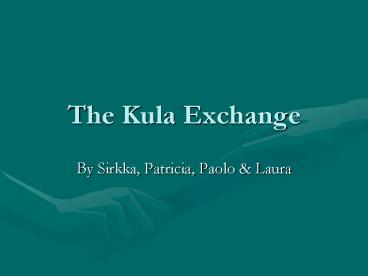The Kula Exchange - PowerPoint PPT Presentation
1 / 12
Title:
The Kula Exchange
Description:
As Annette Weiner says ' The world of Kula', where men have the freedom to ... here was based on Annette Weiner's account of the Trobriander society (1988) ... – PowerPoint PPT presentation
Number of Views:1021
Avg rating:3.0/5.0
Title: The Kula Exchange
1
The Kula Exchange
- By Sirkka, Patricia, Paolo Laura
2
Papua New Guinea
3
The Kula Ring
4
What is the Kula?
- Custom of Trobriander society
- Involves the exchange of an armshell for an
equally valued necklace - Armshells and necklaces link each partner with
the next and move in opposite directions - Value of shells initially based upon their size,
color and the fineness of their polishing
5
The objects of Exchange
A valuable armshell
A typical necklace
6
Male roles in the Kula exchange
- The main role of a man in Kula is direct
engagement in individual political action, i.e.
to gain fame through profitable transactions. - They are also normally the people who do the
transactions, or the shell and necklace giving.
Normally, they make the decision of who to
initiate a path with, which shell (or necklace)
to give to whom, which paths and partners to keep
alive etc.
7
Female roles in the Kula exchange
- Main role the guardianship of matrilineal
identity. - Women represent a small number of participants.
They are often players of great renown but they
seldom actually travel on the overseas voyages to
adjacent Kula villages, sending an intermediary
to do the actual transactions for them.
Females also play a stability role in the Kula,
because even if the Kula exchange of the husband
isnt going well, his real happiness depends on
family. As Annette Weiner says The world of
Kula, where men have the freedom to pursue their
individual fame, remains deeply tied to the
world of the born, where yams and womens wealth
demand continual production and care.
8
KulaReciprocity?
Reciprocity a transaction between between two
parties, whereby goods and services of roughly
equivalent value are exchanged. (Haviland, 1996)
Really Kula exchanges are a mix between
generalized reciprocity (in which the value of
the gift is not calculated, nor is the time of
repayment specified) because it is normal for the
giver to wait periods of eight to ten years
before receiving the equivalent of the gift he
gave, and negative reciprocity (in which the
giver tries to get the better of the exchange)
because the political nature of the Kula exchange
means that all partners are trying to get the
better of everyone else. Men draw on all their
negotiating skills, material resources and
magical expertise to gain access to the strongest
partners and most valuable shells. (Haviland
1996) Competitiveness is very alive in Kula
exchange as one of the main points is to gain
influence and prestige as a valuable partner.
9
Functions of the Kula
- To gain influence, power fame
- Creates history through exchanges
- Creates relationships with partners/friends
- Provides a chance of personal fulfillment
- Spreads propaganda
- Emotional function
10
Value
- The Trobrianders define value through
- the value is proportional to the duration of a
relationship/Kula exchange with the
partners/friends - the quality of the object exchanged among the
partners defines the value of that trade - the value of these relationships is connected to
the image that a person has (a trustworthy person
will have greater possibility to increase his net
of relations)
11
Etc.
- The information presented here was based on
Annette Weiners account of the Trobriander
society (1988). - However, Haviland presented a slightly altered
viewpoint in his textbook (1996), seeming to
stress more the historical importance of the Kula
exchange
12
(No Transcript)































